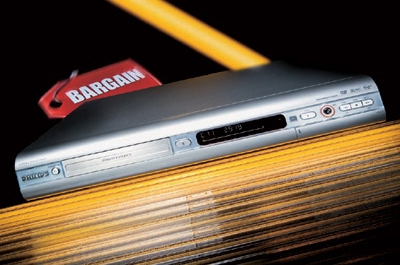DVD Recorders On the Cheap Page 3

|
Continuing its strict adherence to the "plus" party line, the Philips DVDR 615 records only on write-once DVD+R and erasable DVD+RW discs. DVD+RW offers only a few capabilities beyond what's possible with DVD+R. With DVD+R, a new recording is always placed after the ones already on a disc. But with DVD+RW you can overwrite a previous recording.
For some people, it may be decisive that the DVDR 615 is the only deck among the three with an i.Link (FireWire) input for direct digital dubs of DV camcorder footage. And if you're stuck with an old TV that has only an RF (antenna) input, a compelling factor may be the deck's built-in RF modulator, which feeds the recorder's signals into the TV (the other two decks merely pass their RF inputs through unaltered to their RF outputs).
Compared with the playlist-editing capabilities Panasonic gives to DVD-RAM, editing functions are limited with DVD+RWs. On the other hand, it's possible to remove commercials from both DVD+R and DVD+RW recordings. But you can't re-order program segments that are already recorded regardless of disc type.
The manual doesn't mention this, but the best way to get program segments into the order you want with the DVDR 615 is to "assemble edit" them on DVD+RW by recording one segment after another in the desired sequence. This exploits the recorder's ability to overwrite old material, though you need precise cueing for it to work.
Since Philips remote doesn't provide a Commercial Skip button for playback, editing out commercials from your disc copies is even more important here than with the other two recorders. The editing process operates using chapter markers that can be automatically inserted every 5 minutes or so while recording or added after recording is done.
To remove a block of commercials, you cue the disc up to the beginning of the first commercial, add a chapter marker, then cue up the end of the block and insert another marker. You then go back to the first marker and designate that chapter (up to the second marker) as "hidden." During playback hidden chapters are skipped. They aren't erased and can be restored at any time (before finalization with DVD+Rs).
Like previous Philips DVD recorders we've tested, the DVDR 615 produced dubs equal in quality to commercial DVDs in its 1- and 2-hour recording modes. Horizontal resolution gets cut in half to near-VHS quality starting with the 3-hour mode, and vertical resolution is also cut in half, producing a distinctly soft picture, when you reach the 8-hour mode.
But in its 6-hour mode the Philips deck operates at normal 480-line vertical resolution, while the 6-hour modes of both the Panasonic and Pioneer have only 240 lines. Consequently, recordings in that mode on the Philips looked sharper than on the other two, though still soft compared with standard DVDs. Even Philips has to pay the piper, though, and aside from resolution both its 6- and 8-hour modes produced pretty dismal video overall. The image was jerky, particularly when there was lots of action, and full of blocking artifacts and mosquito noise, which made some pictures look very gritty.
Once I got past the cryptic symbols used by the onscreen display, the Philips DVDR 615 proved easy to use. Video performance was fine in the higher-resolution recording modes, though removing commercials was a little cumbersome.





























































